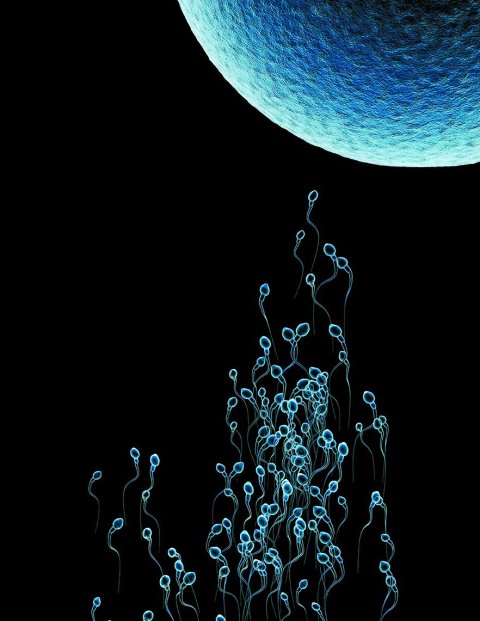Hagai Levine doesn't scare easily. The Hebrew University public health researcher is the former chief epidemiologist for the Israel Defense Forces, which means he's acquainted with danger and risk in a way most of his academic counterparts aren't. So when he raises doubts about the future of the human race, it's worth listening. Together with Shanna Swan, a professor of environmental medicine and public health at the Icahn School of Medicine at Mount Sinai, Levine authored a major new analysis that tracked male sperm levels over the past few decades, and what he found frightened him. "Reproduction may be the most important function of any species," says Levine. "Something is very wrong with men."
That's something you may not be used to hearing. It may take a man and a woman—or at least a sperm and an egg—to form new life, but it is women who bear the medical and psychological burden of trying to get—and stay—pregnant. It is women whose lifestyle choices are endlessly dissected for their supposed impact on fertility, and women who hear the ominous tick of the biological clock. Women are bombarded with countless fertility diets, special fertility-boosting yoga practices and all the fertility apps they can fit on their phone. They are the targets of a fertility industry expected to be valued at more than $21 billion globally by 2020. Even the Centers for Disease Control and Prevention fixates on women, tracking infertility in the U.S. by tallying the number of supposedly infertile women. "It is as if the entire medical realm is shaped to cater to women's infertility and women's bodies," says Liberty Barnes, a sociologist and the author of Conceiving Masculinity: Male Infertility, Medicine, and Identity. "For men, there's just nothing there."
That absence might be understandable if women were solely responsible for the success or failure of a pregnancy. But they're not. According to the American Society for Reproductive Medicine, the male partner is either the sole or contributing cause in about 40 percent of cases of infertility. Past infections, medical conditions, hormonal imbalances and more can all cause what is known as male factor infertility. Men even have their own version of a biological clock. Beginning around their mid-30s, male fertility gradually degrades, and while most men produce sperm to their dying day, those past 40 who help conceive have a greater risk of passing on genetic abnormalities to their children, including autism. "Men are a huge part of this problem," says Barbara Collura, the president and CEO of Resolve: the National Infertility Association.
Startling new evidence suggests male infertility may be much worse than it appears. According to Levine and Swan's work, sperm levels—the most important measurement of male fertility—are declining throughout much of the world, including the U.S. The report, published in late July, reviewed thousands of studies and concluded that sperm concentration had fallen by 52 percent among men in Western countries between 1973 and 2011. Four decades ago, the average Western man had a sperm concentration of 99 million per milliliter. By 2011, that had fallen to 47.1 million. The plummet is alarming because sperm concentrations below 40 million per milliliter are considered below normal and can impair fertility. (The researchers found no significant declines for non-Western men, in part because of a lack of quality data, though other studies have found major drops in countries like China and Japan.) And the decline has grown steeper in recent years, which means that the crisis is deepening. "This is pretty scary," says Swan, who has long studied reproductive health. "I think we should be very concerned about this trend."

Although there have reports of declining sperm counts before, they were easy to ignore. Research on sperm levels has been spotty, using different methodologies and drawing from varying groups, making it difficult to know that the declines some scientists observed were real, and not a function of miscounting. Skeptics of the latest conclusions countered that the new report was a study of many studies—it could only be as good as the work from which it drew. And even if the conclusions of the meta-analysis are accurate, the average sperm count still leaves most men on the normal side of fertile. Just barely.
Yet fertility rates—the number of live births per woman—have drastically declined in the same countries with falling sperm counts. That includes the U.S., where fertility rates hit a record low this year, and where women are no longer bearing enough children to replace the existing population. Women need to average roughly 2.1 children—enough to replace themselves and their partner, with a spare bit to offset kids who don't survive to reproductive age—to keep a country's population stable through birth alone. The U.S. is at 1.8 and dependent on continued immigration to keep the population growing. Sociological and economic factors play a role in the changing size of the American family. Fertility rates were above the replacement level until the 2007 recession, then they plunged. And despite a years-long economic recovery and low unemployment, they're still falling. Pair that with studies showing that nearly one in six couples in the U.S. trying to get pregnant can't do so over the course of a year of unprotected sex—the medical definition of infertility—and it's clear that something beyond economic insecurity is preventing Americans from having as many babies as they want. "When I see birth rates going down, I worry as a fertility doctor that men's sperm counts are declining," says Harry Fisch, a urologist at Weill Cornell Medicine in New York.
This would seem to be the moment for the medical world to throw everything it can at understanding what is happening to male fertility. Yet researchers on male reproduction are forced to rely on less-than-perfect data because the kind of comprehensive, longitudinal studies that might conclusively tell us what is happening to sperm counts have never been done. The irony is that the medical establishment has been accused—with reason—of ignoring the particular needs of women over the years, yet in reproduction it is men whose problems are poorly studied and often misunderstood. Some experts even wonder whether an unconscious desire to ignore threats to male fertility may be tied up in fears over the future of masculinity itself. "Here is direct evidence that that function of reproduction is failing," says Michael Eisenberg, a urologist and an associate professor at Stanford University, referring to the latest sperm-level research. "We should try to figure out why that is."
What we do know about declining sperm counts tells us a great deal about not only reproduction but also the overall health of men—and what it tells us isn't good. Young men may think themselves invincible, but the male reproductive system is a surprisingly temperamental machine. Obesity, inactivity, smoking—your basic poor modern lifestyle choices—can dramatically reduce sperm counts, as can exposure to some environmental toxins. Low sperm counts may presage a premature death, even among men in the prime of their lives who might seem otherwise healthy. "Sperm count decline is the canary in the coal mine," says Levine. "There is something very wrong in the environment." Which means there may be something very wrong with men.

Why Johnny Can't Breed
The study of sperm has always been murky. In 1677, the Dutch draper and amateur scientist Antony van Leeuwenhoek collected his semen immediately after having sex with his wife, examined it under a microscope of his own creation and saw millions of wriggling, tiny "animalcules" swimming in the seminal fluid. The Dutchman was the first person to observe human sperm cells, though he insisted that the sperm alone made an embryo that was merely nourished by the female egg and ovaries. Van Leeuwenhoek was simply following the example of classical thinkers like Aristotle, who believed female partners at most provided a fertile bed of soil in which the seed provided by a man could germinate and flower into a child. It wouldn't be until the 19th century that the true roles of the sperm and the egg were finally sorted out.
All those wriggling "swimmers" van Leeuwenhoek saw are what you would see if you magnified the sample of a healthy fertile man. A sperm cell is built for one thing: motion. Its torpedo-like head is a nugget of DNA containing the 23 chromosomes the male partner contributes to his future child, connected to a long tail or flagellum that propels the sperm to the egg, all running on the cellular rocket fuel of fructose, which is in the semen. Most sperm will never come close to an egg—while a fertile man ejaculates 20 million to 300 million sperm per milliliter of semen, only a few dozen might reach their destination, and only one can drill through the egg's membrane and achieve conception. The chemical makeup of the vagina is actively hostile to sperm, which can only survive because semen contains alkaline substances that offset the acidic environment. That's the paradox of sperm counts—although one healthy sperm is enough to make a baby, it takes tens of millions of sperm to beat the odds, which means that significant declines in sperm counts will eventually degrade overall male fertility. Notes Swan: "Even a relatively small change in the mean sperm count has a big impact on the percentage of men who will be classified as infertile or subfertile"—meaning a reduced level of fertility that makes it harder to conceive.
The fears about male infertility go beyond the stuff of dry science. "It's the virility and fertility dilemma," says Sharon Covington, an infertility therapist in Maryland. "How a man sees himself, and how the world sees him as a man, is often tied to his ability to impregnate a woman." So perhaps it's not surprising that the argument over how much sperm counts are declining—if they are declining—has been less a courteous scientific debate than a ferocious battle that has gone on for more than two decades.

This war began in Denmark, in 1990, when Danish pediatric endocrinologist Niels Skakkebaek began looking into male reproductive health. For years, he had been troubled by the rise in testicular cancer, as well as an increase in the number of boys with malformed testes. He thought assessing sperm quality and quantity might give him a clue to what was happening to his patients.
In 1992, Skakkebaek and colleagues reviewed all the published studies of sperm counts from around the world. (Sperm counts are done by tallying the number of sperm cells in one microliter of semen and then multiplying by 10,000 to estimate the total sperm in a milliliter—not dissimilar from the way police try to estimate the size of a large crowd from a geographic sample.) They calculated that the average sperm count in 1940 was about 113 million per milliliter of semen, and that by 1990 it had fallen to 66 million. In addition, they saw a threefold increase in the number of men with a sperm count below 20 million, the point at which infertility becomes a serious risk.
Skakkebaek's 1992 paper raised concern about the ability of the human species to continue reproducing itself, but skeptics immediately attacked, questioning the reliability of the original sperm studies the analysis was based on. The studies drew from very different groups of men of varying age and fertility. (Sperm count tends to decline with age, and men who gave a semen sample in a visit to a fertility clinic can reasonably be expected to have a lower count than, say, healthy men selected as donors for a sperm bank.) Some scientists believe older and less precise techniques for sperm counting may have artificially inflated the sperm levels of our fathers and grandfathers, which would make the drop to current counts appear steeper than it is.
That's why the new meta-analysis is so important. Swan, Levine and their international colleagues carefully sorted through more than 7,500 peer-reviewed papers before narrowing their search to 185 papers involving 43,000 men from around the world. By excluding studies before 1973, they cut out some of the less reliable older measurements, and they discarded any studies of men with known fertility complications or who were smokers, since smoking lowers sperm count. It's not perfect—no meta-analysis is—but this evidence is the best we currently have, and the conclusions are disturbing. "The community is coming around on this," says Eisenberg. "There have been some good counterarguments about sperm-level decline, but this paper really puts a lot of those arguments to bed."
Environmental Castration
Proving that sperm levels are dropping has been difficult enough, and teasing out the cause is even tougher. Obesity, which has risen dramatically in Western countries while sperm counts have supposedly dropped, is linked to poor semen quality, as is physical inactivity. A 2013 study of American college students found that men who exercised more than 15 hours a week had sperm counts 73 percent higher than men who exercised less than five hours a week. And men who watched 20 or more hours of TV a week had much lower sperm counts than those who watched little to no TV. Stress is also a risk factor, as is alcohol use, which is on an upswing in the U.S., and drug use, which is increasing thanks to the opioid epidemic. Some scientists have theorized that electromagnetic fields from devices like cellphones could degrade semen quality, leading to weak and immobile sperm. Even heat can play a role. We know for certain that high temperatures can kill sperm, which is why the testicles are outside the body, keeping them up to 5.4 degrees cooler. Researchers know that birth rates decline nine months after a heat wave, leading some infertility experts to believe that climate change may actually be a factor in sperm count decline.
Age also matters. In a recent study, Laura Dodge of Beth Israel Deaconess Medical Center looked at thousands of attempts at in vitro fertilization (IVF) performed in the Boston area and tried to gauge the impact of both male and female age on success. Female age remained the dominant factor, but male age factored in as well—women under the age of 30 with a male partner between 40 and 42 were significantly less likely to give birth than those whose male partner was between 30 and 35. That dovetails with other research showing that as men age, their sperm suffers increasing numbers of mutations, which in turn can make it slightly more likely that their children will be born with disorders like autism and schizophrenia. Older mothers may get the blame for infertility, but a new study found that new fathers in the U.S. are on average nearly four years older than they were in 1972, while almost 9 percent of new American fathers are over 40, double the percentage from 45 years ago. "We tell men that age is not an issue, but now we know that the male biological clock is real," says Fisch.
So is it simply modern life itself—obesity, inactivity, stress, cellphones, even older parenthood—that's driving down sperm levels? It's the beginning of an answer, but not the full one. Tobacco use definitely hurts sperm counts, yet smoking has fallen significantly in the U.S. That's one reason a growing band of researchers have come to suspect the influence of toxins in the environment—specifically, endocrine-disrupting chemicals found in compounds like bisphenol A (BPA) and phthalates.
The theory is straightforward enough: These chemicals mimic the effect of the feminizing hormone estrogen and can interfere with masculinizing hormones like testosterone. The chemicals, which are found in many plastics throughout the environment, may be rewiring the sensitive male reproductive system, eroding sperm quality and quantity and even contributing to the sort of testicular disorders that first alarmed Skakkebaek years ago. The production of sperm is tightly regulated by the body's hormones, and so any interference with those hormones—say, through exposure to endocrine-disrupting chemicals—could make itself felt first through damage to sperm quantity or quality. "You could still have sperm, but [levels] might be significantly lower than your father's," says Germaine Louis, the director and senior investigator at the Eunice Kennedy Shriver National Institute of Child Health and Human Development.
Most of the evidence for how these chemicals affect sperm comes from animal studies. A 2011 study found that mice who received daily BPA injections had lower sperm counts and testosterone levels than mice who received saline injections. A startling study from 2016 of fish in U.S. wildlife refuges in the Northeast found that 60 to 100 percent of all the male smallmouth bass studied had eggs growing in their testes—a startling feminization—which researchers linked to endocrine disrupters in the waters. Other studies have shown that phthalates appear to disrupt the masculinization of young lab rats. Animal models aren't perfect, but as University of Texas toxicologist Andrea Gore notes, "the biology of reproduction is incredibly similar in all mammals. We are all vertebrates, and we have the same reproductive organs and processes that develop similarly with the same hormones."
Scientists can't expose humans to endocrine disrupters in a controlled experiment, but some recent research has found associations between exposure to BPA and phthalates in the world, and declining sperm counts and male infertility in adults. A 2010 study of Chinese factory workers by De-Kun Li at Kaiser Permanente found that increasing levels of BPA in urine were significantly linked with decreased sperm count and quality, even among men who were exposed to levels of BPA comparable to men in the general American population. Another study from 2014 followed about 500 couples trying to conceive and found that phthalate exposure among men was tied to reduced fertility. These findings are all associations, which means that while exposure to endocrine disrupters is more likely to be found in men suffering from reduced fertility, it doesn't mean that the chemicals themselves are definitively the cause. But the studies are stacking up. "For some of the endocrine disrupters like phthalates, the basic evidence is strong that they affect reproductive health," says Louis, who carried out the phthalates study.
Even more concerning, but harder to prove, is the damage endocrine disrupters may be doing in utero. As a fetus develops in a mother's uterus, it is barraged by hormones and other chemicals that sculpt development. That includes the male reproductive system—testicles are formed in the womb, and although sperm levels can be altered in adulthood, they seem to be largely set before a boy is born. That means we could see sperm levels continue to decline for years, as boys who were exposed to endocrine disrupters before birth reach reproductive age and run into problems trying to have children of their own. "This trend hasn't turned around, and it's not going to turn around on its own," says Swan, who has been studying the effects of endocrine disrupters for decades. "We don't have a lot of time to lose."
The Baby Un-Boom
If this is a crisis, why is the medical establishment still arguing over the accuracy of statistical methods that approximate sperm levels from a variety pack of studies? Trying to figure out what is happening to sperm levels isn't like trying to create an HIV vaccine. Researchers could follow a cohort of representative men from early adulthood through their reproductive years, taking regular semen samples under the same conditions and tracking lifestyle and environmental factors, including exposure to endocrine-disrupting chemicals. Such long-term studies aren't easy or cheap, but somehow we've managed to pull them off for certain illnesses, like cardiovascular disease and cancer. The future of the human race—whether it has one—would seem to qualify as an important topic to explore in depth. "Why are we messing about with this?" says professor Allan Pacey, a male fertility expert at the University of Sheffield. "Let's just answer the question."
A major, comprehensive study of semen quality has never been funded, however. Doctors are reluctant to even ask men for semen samples, and most men seem reluctant to give one—even though, as Eisenberg wryly notes, "it's a lot more pleasant for the patient than a blood draw."

"Male infertility has been ignored for 30 years," says Christopher Barratt, a professor of reproductive medicine at the University of Dundee in Scotland. "What we understand can be written on a postage stamp."
The average man knows much, much less. Few men could even name the medical specialty that covers male reproductive health—it's urology—and fewer still have ever seen a urologist, given that there are fewer than 12,000 of them in the U.S., about one-third the number of OB-GYNs in the country. Aside from a few online forums, there are no real support systems for men with infertility issues. Many men lack basic knowledge about risk factors for infertility. A 2016 Canadian study found that men could identify only about 50 percent of the potential risks to sperm production, largely missing out on known threats like obesity and frequent bicycling. "Most men just assume that when they want to have children they'll be able to," says Phyllis Zelkowitz, the director of research at the Jewish General Hospital in Montreal and the lead author on the study. "But that isn't the case for a certain number of people."
The continued ignorance of male infertility is, in its way, another form of male privilege. Pretending that pregnancy is almost entirely a female responsibility means that women are forced to carry the burden and the blame when it goes wrong, while men, who are just as vital to healthy conception, rarely worry about how their lifestyles impact their own fertility or their possible children. "Women will often be sent to invasive, expensive procedures for fertility before a sperm test is ever done," says Resolve's Collura.
So men are getting off free while their female partners put themselves through painful and expensive fertility treatments. Well, not exactly. The constant production of new sperm cells makes semen highly sensitive to toxins and disease, making it an ideal surrogate for male health—"like blood pressure," as Louis puts it—beyond what it might signal for fertility. Poor sperm levels and infertility are a clear sign that men's health is failing. One 2015 study found that men diagnosed with infertility have a higher risk of developing health issues like heart disease, diabetes and alcohol abuse, while another connected infertility to cancer. "Semen quality isn't just about a couple getting pregnant," says Louis. "There is increasing evidence at the population level that men with diminished semen quality die earlier and have more chronic diseases. This is as important to health as any disease state."
That male reproductive health goes mostly ignored in the face of those concerns is a striking example of what Cynthia Daniels, a political scientist at Rutgers University and the author of Exposing Men: The Science and Politics of Male Reproduction , calls the "paradox of male privilege." A society that values men over women would presumably pour money and resources into determining exactly what is happening to sperm counts and reproductive health. But that would risk confirming that men, who are socially conditioned to think of themselves as indestructible, are in fact vulnerable—and vulnerable in that part of themselves most vital to manhood. At a moment when other talismans of masculinity, like the ability to financially support a family, are under assault, acknowledging the risk to reproduction may feel even more threatening to men. "Recognizing the male reproductive health problem unravels the notion of who men are and how they achieve masculinity," says Daniels. "It seems to be more important to protect our norms of masculinity and traditional gender relations than it is to address the real health needs of men."

One way to accomplish that goal is to enable men to take responsibility for their reproductive health. That's what Greg Sommer, the chief scientific officer of Sandstone Diagnostics, is trying to do with Trak, a kit men can use to evaluate their sperm levels. It's one of several similar do-it-yourself sperm testing services that offer men the chance to assess their own fertility without stepping inside a doctor's office. That approach is more than a mere convenience because men are significantly less likely to go to the doctor than women, especially men in their prime reproductive years, when their health is otherwise likely to be good.
Real, substantive change is needed from the medical and funding communities to address the male infertility crisis. It may be true, as skeptics countered after the publication of Swan and Levine's meta-analysis, that we're a long way from declining sperm counts heralding the end of the human race, at least as portrayed in works of pop art like The Children of Men and The Handmaid's Tale . Millions of men and women are having children every day—even if an increasing number need artificial help like IVF. Yet more and more countries find themselves unable to raise their fertility rates above the level needed to replace their population, leading one prominent demographer to prophesy that the world has already reached "peak child."
It's difficult not to wonder and worry about what will come next. "It's an inconvenient message, but the species is under threat, and that should be a wake-up call to all of us," says Skakkebaek. "If this doesn't change in a generation, it is going to be an enormously different society for our grandchildren and their children."
Assuming, of course, they can have them.















